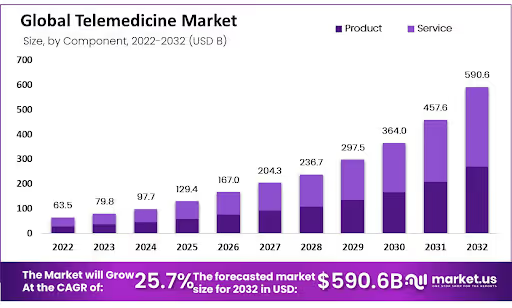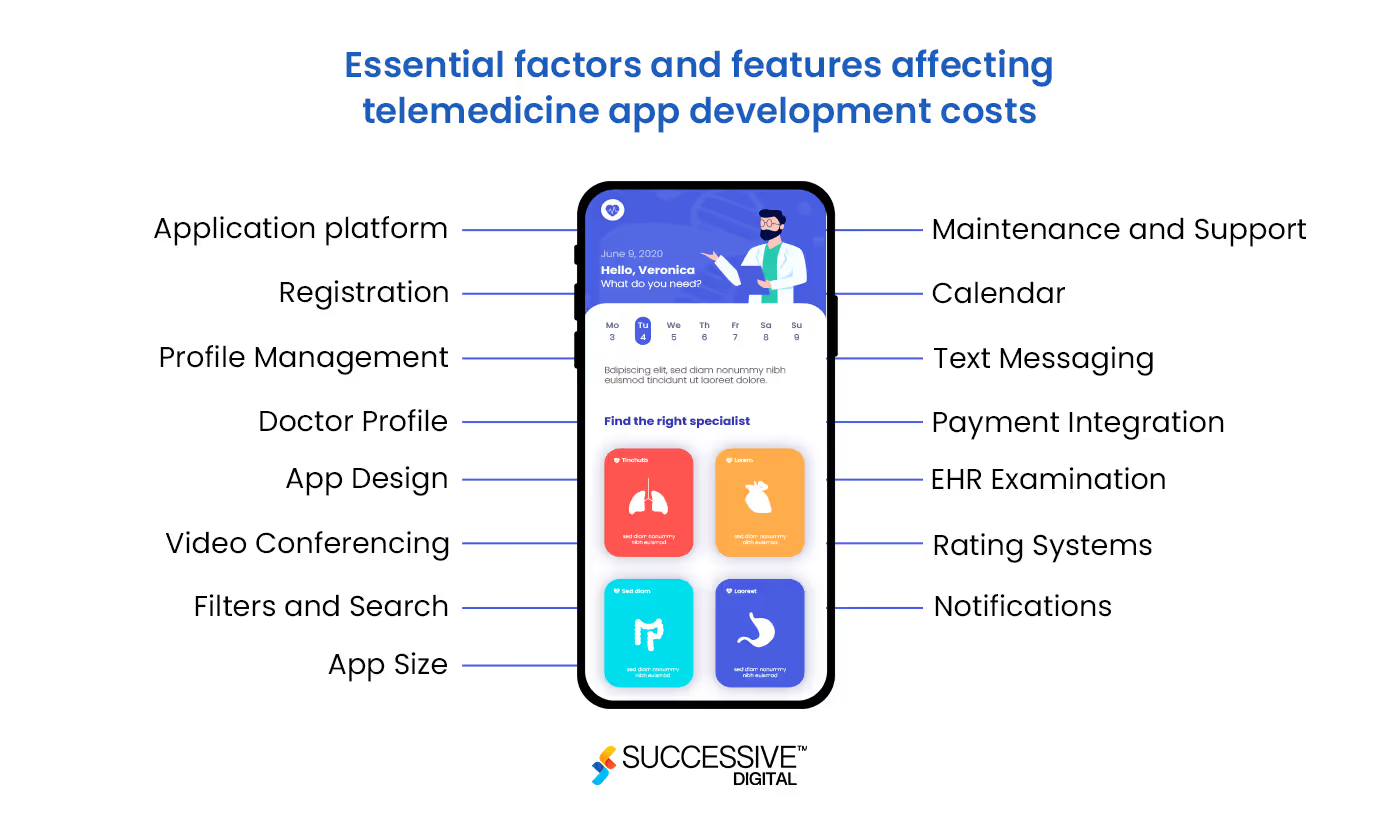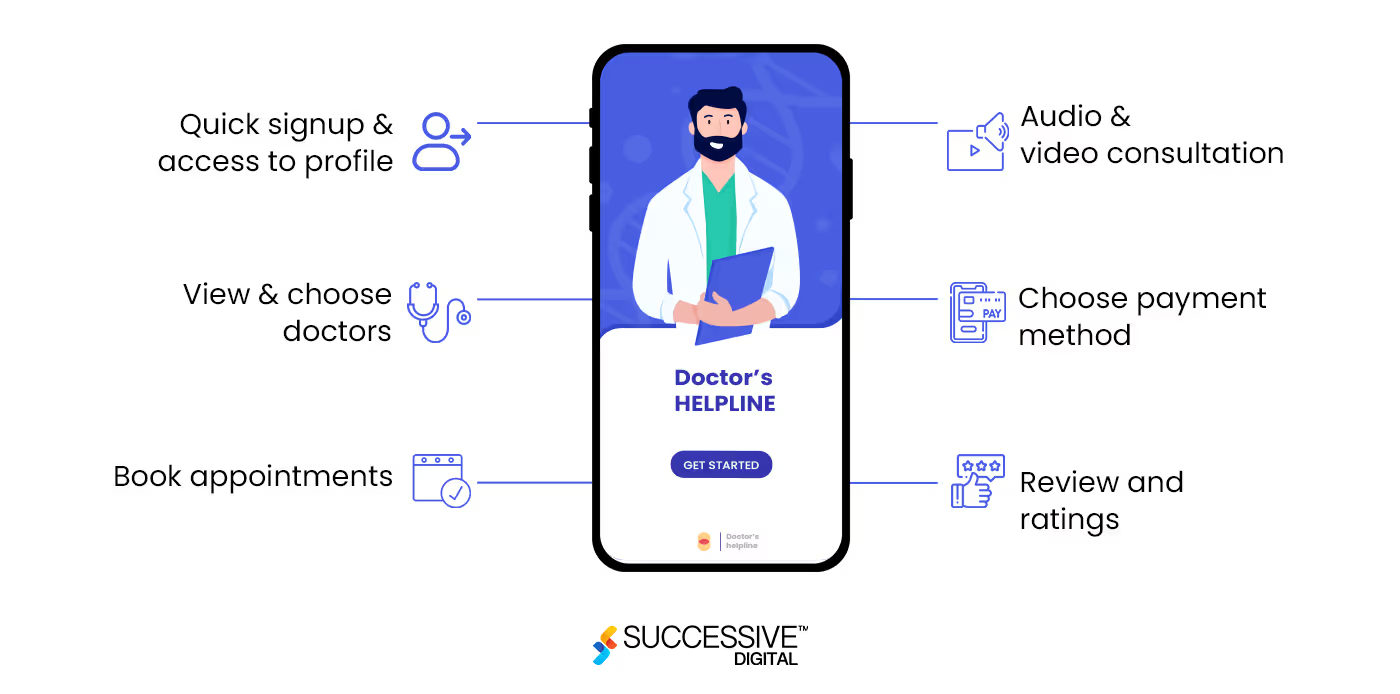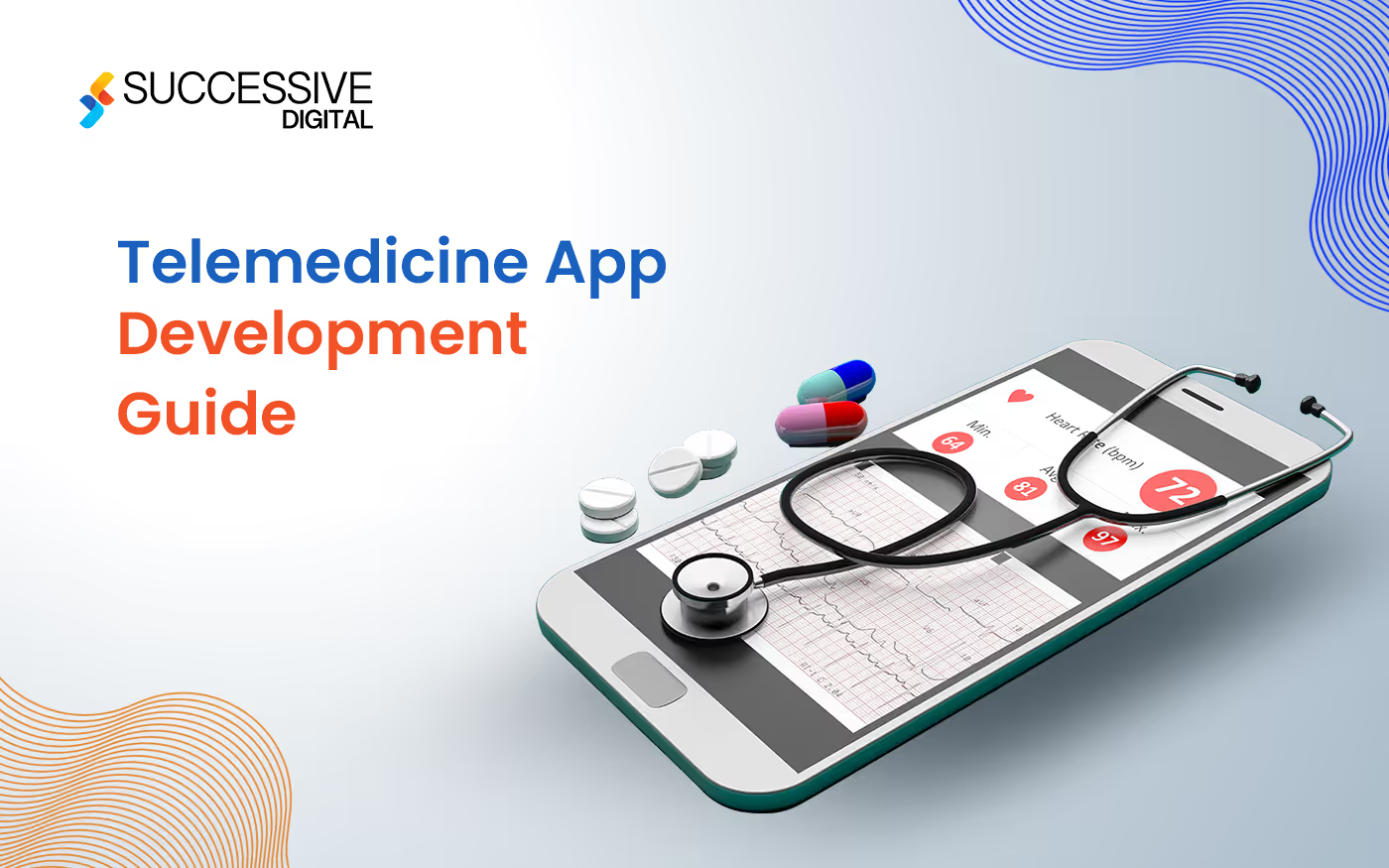How we access healthcare services has undergone a significant transformation in recent years. With the advent of telemedicine apps, people can now receive medical advice, consultations, and even treatment from the comfort of their own homes. This revolutionary technology has significantly changed the healthcare industry, making it more accessible, convenient, and cost-effective than ever before. With telemedicine apps, patients can receive timely medical attention, regardless of location or time.On the other hand, doctors can provide remote consultations, monitor patients, and prescribe medication through these apps. As we move towards a more digitalized world, telemedicine apps are poised to become an integral part of healthcare services. In this article, we will take a closer look at the role of telemedicine apps, top trends driving mobile app development for virtual care, its development processes, and the cost associated with telemedicine software development that plays a significant role in shaping virtual care setup.Table Of Content
- Why Are Telemedicine Apps So Popular?
- What Are The Types Of Telemedicine Apps?
- Why Is Even A Telemedicine App Required?
- 3 Common Healthcare IT Integrations Crucial For Telemedicine App
- List Of Popular Telemedicine Apps Has Revolutionized Virtual Healthcare
- Who Needs To Invest Into Telemedicine App Development?
- What Do You Need To Know First Before Stepping Into Telemedicine App Development?
- How Much Does It Cost To Build A Telemedicine App?
- Trending Technologies Influencing The Growth Of Telemedicine Apps
- What Is Telemedicine App Development Process?
- Telemedicine App Development Team Composition
- How Successive Can Help In Developing A Telemedicine App?
- Case Study: Successive's Telemedicine App Development Success Stories
- Conclusion
Why Are Telemedicine Apps So Popular?
Telemedicine applications for healthcare are rapidly growing in popularity, with more and more people using mobile apps to access healthcare services. According to a report by Mordor Intelligence, the global telemedicine market was valued at $45.5 billion in 2020 and is expected to reach $175.5 billion by 2026, growing at a CAGR of 24.7% during the forecast period. The COVID-19 pandemic has also accelerated the adoption of telemedicine, as people are looking for ways to access medical services without leaving their homes.Telemedicine apps offer numerous advantages over in-person doctor visits. For one, telemedicine apps are more convenient and cost-effective, as patients can receive medical attention from the comfort of their own homes. Telemedicine apps also allow patients to avoid long clinic wait times, which can be frustrating and time-consuming. Additionally, telemedicine apps are more accessible to patients who live in remote or rural areas, where access to healthcare services can be limited.However, keep in mind some limitations that come with telemedicine apps. These apps may not be suitable for all medical conditions, as some conditions may require a physical examination. Additionally, telemedicine apps may not be able to provide the same level of care as in-person doctor visits, as doctors may not be able to perform certain procedures or tests remotely.Mobile apps that support telehealth also allow doctors to monitor patients remotely by using sensors or wearable devices to collect data on patients' vital signs. This data can then be used to provide personalized medical advice and treatment recommendations. Remote patient monitoring is particularly useful for patients with chronic conditions, as it allows doctors to monitor their condition and provide timely medical attention when necessary.
What Are The Types Of Telemedicine Apps?
You can leverage telemedicine app development solutions and revolutionize healthcare services for digital channels by transforming the traditional processes with digital advantages available or known basically as store and forward, remote monitoring, and real-time interactive methods. Integrating these functionalities within your mobile telehealth application allows you to establish an interoperable healthcare system. Let’s understand them and the other four examples of telemedicine apps in detail below.
1. Store And Forward (Store And Forward Telemedicine Examples)
Store and forward is a telemedicine approach where medical information, such as images, videos, or patient data, is captured and stored for later transmission to a healthcare professional or specialist. In telemedicine app development, the store and forward functionality allows users to upload and send medical data to healthcare providers for review and analysis conveniently.
2. Remote Monitoring
Remote monitoring in telemedicine refers to the ability to monitor patients' health remotely, usually through the use of wearable devices, sensors, or other connected devices. These devices collect data on vital signs, activity levels, or other relevant health metrics, which are then transmitted to healthcare providers for analysis and monitoring. In the context of telemedicine app development, remote monitoring involves integrating such devices with the app to enable real-time or periodic data transmission.
3. Real-Time Interactive
Real-time interactive functionality in a telemedicine app enables immediate communication and interaction between patients and healthcare providers. It allows for live video consultations, instant messaging, or audio calls, simulating an in-person visit with the added convenience of remote access. With real-time interactive features, patients can connect with healthcare professionals in real time, discuss their symptoms, receive medical advice, and even undergo virtual examinations. This type of telehealth app was highly popular during the Covid19 period and widely adopted among patients and providers.
4. Teleneuropsychology
Teleneuropsychology is defined as the application of audio and visual technologies that allows remote clinical encounters to conduct neuropsychological evaluations. Teleneuropsychology (TeleNP) is one of the fastest-growing and most promising practices within the telemedicine landscape. Teleneuropshy is a well-accepted telemedicine practice by patients and practitioners, reporting a 98% satisfaction rate among adults. One of the successful teleneuropsychology applications like Cliniclive (web app for practitioners and mobile app for patients) helps in providing neuropsychological consulting to patients remotely through video conferencing for standard evaluation tests, diagnosis, treatment, and follow-up.
5. Telenursing
Telenursing is another fastest-growing telemedicine vertical that connects nurses and patients for remote nursing care. This type of application is gaining popularity among chronic patients, and caregivers require continuous and on-demand patient monitoring assistance. Telenursing app development services are also helping healthcare organizations to radically reduce the cost of nursing and improve the value of care.
6. Telepharmacy
The telepharmacy market is expected to register a CAGR of 25.3% over the forecast period of 2022-2027. During the wake of Covid 19 outbreak, telepharmacy apps helped decrease the potential for infectious exposures. It is widely adopted among patients and practitioners for pharmacological recommendations. These applications help regulate patients' medications through video or phone-based consultations.
7. Telerehabilitation
Telerehabilitation is another telemedicine practice that uses advanced technological solutions to speak with patients and does clinical assessments and therapy. Webcams and video conferencing are mostly used tools in communicating symptoms and clinical progress. Telerehabilitation app development includes developing features and functionalities that support evaluation, assessment, monitoring, prevention, intervention, supervision, education, consultation, and coaching.These are all sorts of telemedicine apps available for clinicians and patients to use for effective and efficient medical care requirements. These applications provide better and wide options to acquire and access the care they need.
Why Is Even A Telemedicine App Required?
Though the global pandemic has gone, its traces can still be felt in how conscious people have become towards social distancing or remote access. Henceforth, enterprise healthcare companies are striving to optimize the patient experience for the people of the digital age. The patients and practitioners, and providers demand digital-focused offerings to interact with patients.According to Statista, the market value of EHRs by 2027 is forecasted to reach 47.2 billion U.S. dollars which was 29 billion U.S. dollars in 2020.Strict regulations and reimbursement policies were also the biggest challenges to transitioning to the new solution and services. However, things have changed dramatically since such restrictions were soon lifted when Covid19 hit, and regulatory bodies asked enterprise healthcare providers to quickly stand up to fulfill the provider's needs to continue to see patients while in-person clinics were closed.Statista, in the same report, also mentioned the stable increase in the adoption of telemedicine services among Americans and believes that it will touch up to nearly 280 billion dollars by 2025.
3 Common Healthcare IT Integrations Crucial For Telemedicine App
Integration is nothing but connecting two or more healthcare IT systems so that together these can perform to their optimum and serve the purpose it is designed for. One of the common reasons healthcare IT system integrations are required for exchanging critical data, improving operational efficiency, and reducing overall healthcare time and cost. Let's have a look at the most common healthcare IT integrations.
EHR And EMR Integration
Integrating a telemedicine app with EMR and EHR systems is a critical component to consider, as it can help improve the quality of care and increase the provider's efficiency. EHR and EMR integration with telemedicine or telehealth apps promotes interoperability within healthcare systems since it allows bidirectional workflow between systems; henceforth, physicians can use a single platform to keep workflow records instead of duplicating them in two or more systems. A telemedicine app with EHR and EMR integration bridges the gap between telemedicine apps and patient data. It facilitates providers with faster diagnosis, lower prescribing errors, and supports science-based decision-making.
IoT And Wearable Device Integration
Since telemedicine apps are supposed to provide on-demand healthcare support, integrating telemedicine with IoT and wearable devices provides a continuous flow of health data. It empowers patients to play an active role in their health management. The application also facilitates remote patient monitoring by enabling healthcare providers to keep track of patient health and intervene when necessary.
Hospital Management System Integration
The next and third integration that your telehealth app requires is the hospital Management system. If you plan to invest in telehealth software development to expand your hospital and healthcare efficiency, integrating a hospital management system with your telehealth app will allow you to bring all real-time operational management information within a handheld device. Whether providing real-time updates on patient data or seamless care coordination, efficient appointment scheduling, or billing and documentation, you can enhance the telemedicine experience and virtual care with an integrated approach ensuring the highest quality of healthcare delivery.
List Of Popular Telemedicine Apps Has Revolutionized Virtual Healthcare
Numerous telemedicine apps are available in the market, each with unique features and benefits. Some of the top telemedicine apps available in the market include:

- Teladoc: Teladoc is a telemedicine app that allows patients to connect with doctors through video conferencing. Patients can use this app to schedule appointments, receive medical advice, and even receive prescriptions for medication.
- Doctor on Demand: Doctor on Demand is a telemedicine app that allows patients to connect with doctors through video conferencing. Patients can use this app to receive medical advice and even prescriptions for medication.
- Amwell: Amwell is a telemedicine app that allows patients to connect with doctors through video conferencing. Patients can use this app to schedule appointments, receive medical advice, and even receive prescriptions for medication.
Who Needs To Invest Into Telemedicine App Development?
As per the data provided by Market.us, the telemedicine market on a global scale was valued at USD 63.5 billion in 2022. It is anticipated to witness significant growth and is projected to reach USD 590.9 billion by 2033. This forecast period of 2023 to 2032 is expected to exhibit a compound annual growth rate (CAGR) of 25.7%.

Some stats also prove the growth and demand for a better telemedicine experience.
- Web and mobile will be considered the dominant delivery mode in 2022.
- North America dominated the market with the highest revenue share of 36% in 2022.
- Asia Pacific is expected to grow at the highest CAGR during the forecast period.
Henceforth, telemedicine app development solutions can be lucrative for entrepreneurs and enterprise healthcare institutions looking for new revenue streams, improving healthcare quality and services and increasing operational efficiency while decreasing overall costs. The top two players who would like to invest in telemedicine app development can be entrepreneurs and enterprise healthcare providers. Let’s check how these healthcare entities can benefit from telehealth app development services.
Entrepreneurs
Every telemedicine app available in the market is supposed to bridge the gap between patient and provider for healthcare quality and solution services. Since telemedicine is not fully tapped yet and lots of renovation and digitization are yet to happen, you can embark on an entrepreneurial journey with an app idea that solves existing problems. You can begin by developing a telehealth app with basic functionality and grow it as demands surpass. Whether it's telepharmacy or telenursing, EHR/EMR or customer-focused fitness app, hospital information management app, or a complete wellness platform, identify the gap in the industry and embark on an entrepreneur journey. You can go with venture funding or an in-app monetization strategy based on the nature of your application to get rewarded for your business idea.
Enterprise Healthcare Institutions
As telemedicine becomes, increasingly popular and patient demand for virtual healthcare services rises, having a telemedicine app can give an enterprise healthcare organization a competitive edge. If you are one of the decision-makers from an enterprise healthcare company, you may think of investing in telehealth app development to enable continuity of care by promoting virtual follow-up visits and ongoing monitoring of patients that enhance patient engagement. Apart from this, integrating a telemedicine app within an existing enterprise healthcare setup helps you expand the reach and accessibility of care among a larger patient population, will increase your market share, save cost and improve operational efficiency.Want to know the exact impact of telehealth app development on your enterprise healthcare institution? Connect with our specialist today.
What Do You Need To Know First Before Stepping Into Telemedicine App Development?
Despite many benefits for businesses and patients, telehealth software development is a challenging trial for which you should be ready with the proper knowledge. Healthcare, being highly regulated and compliance bound, requires adopting a few development guidelines for effective launch and operation with patients' healthcare needs. Let's know them in detail.
1. Regulatory Compliance
Patient healthcare information is crucial data for any state. Since telehealth apps also deal with patients' sensitive information, you must get familiar with all the regulatory and compliance requirements for the state you want to develop the application. Here is a list of regulatory standards (country-specific) that you must bear in mind and build your telehealth app accordingly:
- HIPAA (United States)
- Complying with PIPEDA (Canada)
- Data Protection Directive 1995/46/EC and the e-Privacy Directive 2002/58/EC/IEC 62304 (Europe)
- GDPR (United Kingdom)
- IMLC (Columbia)
2. Security
Besides developing a HIPPA-compliant application and maintaining a complete infrastructure accordingly, you must be concerned about data safety and security in transit and at rest. Tools, algorithms, and protocols such as AES 128 Bit and SHA 256 can be leveraged for telehealth app development. Despite having protocols and tools in place, security can be breached if the user makes a mistake using the application. To ensure that your virtual care app is secure to use by users in all ways, you can extend the effort by performing self-assessment or professional vulnerability and penetration testing services as well as quality engineering services, to identify any bugs or breach possibilities and fix them before the app launch.
3. Video Quality
Quality video streaming is a central necessity for all kinds of telemedicine applications. Since patients use telemedicine mobile apps for video consultation, a bad-quality video can ruin the user experience and turn into an unsatisfied patient. Bad-quality video streaming can lose business since it also disrupts the diagnosis process. Therefore, ensure that your telemedicine app's video quality is good irrespective of the device. Besides the video streaming quality of the mobile app, it also needs to be good on web apps used by doctors. Applications that require expensive or the latest electronic devices would not be well-received by many.
How Much Does It Cost To Build A Telemedicine App?
Developing a telemedicine app with basic features can cost around $40,000 to $55,000. However, a full-fledged and advanced-level telehealth app can cost around $90,000 to $200,000.

As the image above shows, the number of features and functionalities grows - telemedicine app development cost and time increase.Read the detailed guide on healthcare app development cost to help you estimate your budget.
Trending Technologies Influencing The Growth Of Telemedicine Apps
The realm of healthcare, with the help of telemedicine apps, is no longer a geographical or logistical challenge. Advancement in technologies, including development methods, hostings, and customer-focused innovation, has made it possible to transform virtual care into a full-fledged solution. Let’s discuss some of the popular technologies influencing the growth of telemedicine apps.
I. Artificial Intelligence (AI)
Artificial intelligence or AI enables telemedicine apps to offer advanced features such as natural language processing for voice recognition and chatbot interactions, image and pattern recognition for diagnostic support, and predictive analytics for personalized patient care. AI algorithms can analyze large amounts of patient data to detect patterns, diagnose accurately, and provide treatment recommendations.
II. Internet of Things (IoT)
IoT devices like wearables and remote patient monitoring devices can transmit real-time patient data to telemedicine apps. This data includes vital signs, activity levels, medication adherence, and other health-related information. Integrating IoT with telemedicine apps allows healthcare providers to monitor patients remotely, provide timely interventions, and deliver personalized care based on continuous data collection.
III. Cloud Storage
Cloud storage enables secure and scalable storage of patient data in telemedicine apps. Healthcare providers can securely access and share patient records, medical images, test results, and treatment plans anywhere and anytime. Cloud storage facilitates seamless data exchange between healthcare providers, improving care coordination and supporting remote consultations.
IV. Blockchain
Blockchain technology offers enhanced security and privacy for telemedicine app development. It enables secure storage and sharing of patient health records, protecting sensitive information from unauthorized access. Blockchain can also facilitate secure and auditable transactions, such as verifying consent for data sharing and managing telemedicine billing and payments. With blockchain app development services, healthcare providers can instill utmost security and reliability in their telemedicine applications.
V. Big Data
Telemedicine apps generate and collect vast amounts of patient data, including medical records, imaging data, and real-time monitoring data. Big Data analytics tools can process and analyze this data to uncover patterns, trends, and insights that can inform clinical decision-making, improve population health management, and drive research and innovation in telemedicine.
VI. Deep Learning
Deep learning algorithms, a subset of AI, can be utilized in telemedicine apps to analyze medical images, such as X-rays, CT scans, and pathology slides. These algorithms can assist healthcare providers in diagnosing diseases, identifying abnormalities, and providing treatment recommendations. Deep learning enhances the accuracy and efficiency of image analysis, supporting remote diagnosis and reducing the need for in-person consultations.
VII. Chatbots
Chatbots integrated into telemedicine apps provide virtual assistance and support to patients. They can answer common medical questions, provide information about symptoms or medications, schedule appointments, and triage patients based on their symptoms. Chatbots improve patient engagement, provide 24/7 support, and reduce the burden on healthcare providers by handling routine inquiries.
What Is Telemedicine App Development Process?
The Telehealth app development process begins with collecting engineering requirements and software planning, deciding on telehealth app features and app development model, selecting the appropriate tech stack, and launching and updating as per user’s feedback. Let’s check them in detail and understand their significance in developing a winning telehealth software.
Step 1. Requirements Engineering
Telemedicine app requirement engineering is the first stage of developing an app, where a Mobile App development company helps you with market research and competitor analysis when you want to launch the app as a product. In case you are from a healthcare organization, telehealth business analysts will help with identifying the business needs specifications and software requirements elicitation.The process also helps you identify other significant aspects of developing an app, such as considering the compliance and standards you may need to maintain based on the state your app will be operating. For example, you may need to make your app architecture design according to HIPAA-compliant in the USA. You can decide on further modules essential to your app to make it more functional. Budget planning is yet another crucial aspect that you can decide at this stage to get a clear scope of telemedicine app development.
Step 2. Project Planning
Project planning is another crucial step in app development as it helps in identifying the scope and goal of the app development. You can decide the features, functionalities, and objectives and accordingly plan resource allocation such as time, budget, and developers essential for smooth project progress.In this step, you also decide the time management and SDLC processes, whether to go with agile or DevOps, and include Scrum and Kanban in complex projects that require team flexibility. Next is quality assurance, as you must ensure the developed app's quality. By defining quality standards, establishing testing methodologies, and incorporating quality assurance activities into the project plan, you can systematically monitor and verify the app's functionality, performance, security, and user experience. This helps in delivering a high-quality app that meets the expectations of users and stakeholders.
Step 3. UX And UI Design
In the process of developing a telehealth application, it is crucial to identify the main user scenarios, such as video appointment scheduling and prescription renewal, while visualizing the core functionality that the app should offer. This includes features like patient-doctor messaging and vitals tracking. Additionally, mapping convenient user journeys for patients, physicians, nurses, and administrators helps ensure a seamless and user-friendly experience for all involved.To provide a tangible representation of the app's interface, UI prototyping is employed, allowing stakeholders to visualize how the telehealth app will look and function. Furthermore, a key aspect of the development process involves UI design, where attractive graphic interface elements are created to enhance the overall aesthetics and usability of the app. The telehealth application can be optimized through these steps to meet user needs and provide a visually appealing and intuitive platform for healthcare interactions.
Step 4. Decide Features

Audio and Video Conferencing
- Allow patients and providers to connect and check patients' health.
- Provide care instructions.
- Analyze the medical history and test in real time.
Image and Video sharing
- Share medical reports or videos of the affected area.
Text Messaging
- This communication medium can be used in case of a poor internet connection.
- Provide convenience to patients and providers to communicate in their comfortable time.
Self-assessment
- A dashboard to help patients manage their own health effectively
Step 5. Decide App Development Method
You can develop your telehealth app in three methods that best suit your needs.
- Native App Development
The native app development process allows you to offer better functionality. But you need to write app code separately, which is time-consuming and increases overall development costs. If you have a significant capital investment and a solid vision to cover the global market, native mobile app development for telehealth apps is the best option.
- Cross-Platform App Development
Cross-platform app development allows you to write and maintain one codebase and run mobile apps on different platforms. It saves development time and cost but runs slower than native apps. Cross-platform mobile app development is for you if you can compromise to some percentage with performance and functionality and do not have high capital.
- MVP App Development
One of the best and most prevalent ways to get an app to market faster is by developing it through the MVP method. MVP app development requires low capital but less time to launch the app within the market. Going through MVP development also means launching the app with essential features and functionalities for early-stage users. Based on honest user feedback, these applications can further be enhanced and scaled with better functionalities, features, and other advanced requirements. Airbnb, Dropbox, Amazon, and Facebook are all one of the best examples of MVP app development.
Step 6. Decide Technology Stack
CategoryTechnologiesFrontendSwift/ Java & Kotlin/ HTML, CSS, JavaScript/ Flutter, ReactNative, and othersBackendPHP/NodeJS/PythonDatabaseMySql/MongoDB/PostgresqlCloud ServerAmazon AWS, Azure, GooglePaymentGoogle Pay, Apple Pay, PaypalSMSTwilioGeolocationGoogle Places APIs
Step 7. Launch And Maintain A Telemedicine App
The job of a telemedicine app developer doesn’t end once the application is built. You can also ask for expert assistance in launching the app to the right platform and further optimizing it for better usability and performance needs as the user base grows.
Telemedicine App Development Team Composition
Always remember that it is not just the software developers you need as your extended team to develop your telehealth application. You need a complete IT department as your backend team to build and launch the app. Henceforth, your team composition will look like this:
- Frontend Developer
- Backend Developer
- UI/UX Designer
- Business Analyst
- Project Manager
- QA Engineer
- DevOps Engineer
- Team Lead
One of the best advantages of working with a telemedicine app development company is that you can hire the resources you need for any range of experience from them on your requirement basis. These software development companies are your one-stop destination to hire resources on-demand and scale down when required.
How Successive Can Help In Developing A Telemedicine App?
In the last 12 years, we have successfully provided different healthcare services. Having experience supporting traditional medicare solutions, we combine hands-on expertise with innovation-led projects ensuring interoperability and operational efficiency. During the wake of Covid19, we also helped modernize and migrate EHR systems into cloud-based platforms to provide remote monitoring and consulting solutions. In addition to this, we also helped develop a complete telemedicine app from scratch with a quick turnaround time that enhanced patient care and outcome.Yes, we have a team of healthcare-focused IT professionals, including UI/UX designers, app and web developers, compliance specialists, business analysts, QA engineers, DevOps specialists, and project managers with seasoned experience. To add value to your telehealth mobile app development, we assist you with healthcare-specific consultations, competitor analysis, functionality testing, feature and usability decision-making, full-stack development, DevOps-based development and deployment, and others.
Case Study: Successive's Telemedicine App Development Success Stories
Conclusion
Telemedicine app is the future of virtual healthcare services. Since patients and practitioners are more inclined towards digital services for basic to advanced care solutions, health tech solution will be required to transform and revolutionize different aspects of traditional healthcare services and solutions.Hence, it's the right time to partner with a telemedicine app development company and get your telehealth app into handheld devices for your target users.
.avif)










.jpg)









